Flexible, Fast, and Reliable Corrosion Under Insulation (CUI) Integrity Management Solution.
Lyft® can scan through thick insulation, as well as aluminum, stainless steel, and galvanized steel weather jackets. It also benefits from a range of PECA, single-element PEC, and application-specific probes to support various applications. Who else but Eddyfi to reinvent an eddy current technique and redefine CUI programs?
Got Lyft
Details
Benefits
- Inspect through thick insulation and fireproofing
- Save on insulation removal costs
- Real-time imaging for instant results
- Unrivalled productivity with PECA
- Easy setup with SmartPULSE™ calibration
- Highest confidence with Tau-scan™ and PermTool™ advanced analysis tools
Applications
- Corrosion Under Insulation (CUI) and Fireproofing (CUF)
- Insulated pipes and vessels
- Through aluminum, stainless steel, and galvanized steel weather jackets
- Safe, in-service scab corrosion assessment, no need to remove the scale
- In-service inspection of storage tank annular plates
- Underwater and splash zone structures
- Ship deck inspections through tiles and coatings
Want to see Lyft in action? Book a demo!
CUI Programs Redefined
Corrosion Under Insulation (CUI) is possibly the greatest unresolved asset integrity problem in the industry. Current methods for measuring wall thickness over insulation (Liftoff) without removing it all have severe limitations. Lyft® is a high-performance solution reinventing Pulsed Eddy Current (PEC).
Lyft can scan through thick insulation, as well as aluminum, stainless steel, and galvanized steel weather jackets. It also benefits from a range of PECA, single-element PEC, and application-specific probes to support various applications. Who else but Eddyfi would reinvent an eddy current technique, integrate high-productivity array to the solution and completely redefine CUI programs?
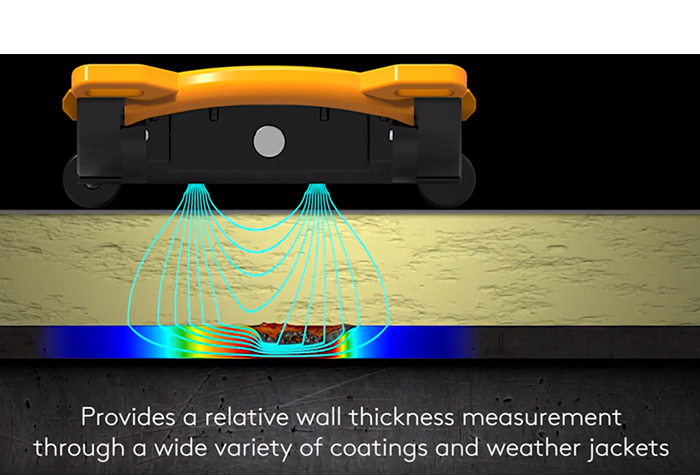
Automated Software for Reliable and Repeatable Results
The Lyft is packed with automation and advanced algorithms that remove operator-specific dependence, thanks to the power of the SmartPULSE™ technology. It automatically optimizes pulser and receiver parameters (gain, duration, time gates, filters, etc.). SmartPULSE also adjusts Wall Thickness (WT) measurements to ensure optimal performance and repeatability, while limiting the need for advanced knowledge of pulsed eddy current. The user-friendly multi-touch software also includes several innovative features, including real-time C-scan imaging (grid-mapping and dynamic modes), complete wall thickness measurements (ID and OD corrosion), as well as complete inspection management and reporting capabilities.
Ask an ExpertWe offer our software either via yearly subscription or perpetual license with built-in updates. Learn more about it and see how simple it is here.
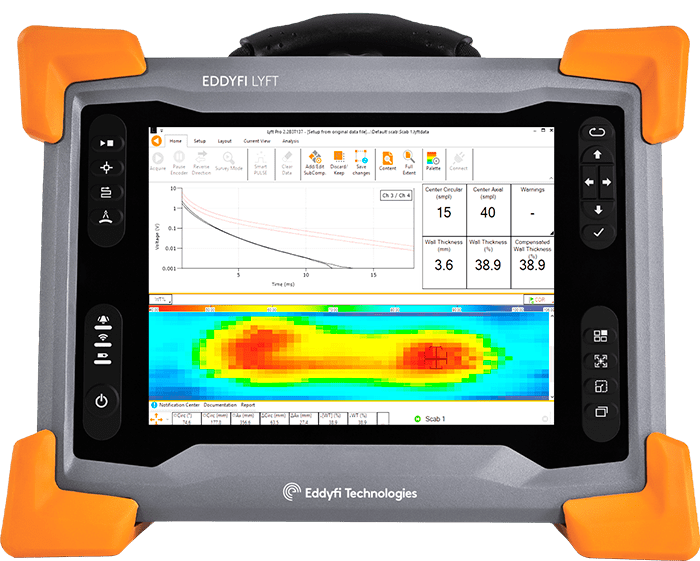
Unique to Lyft—Wall Thickness Measurement Tool for Smaller Flaws
Under sizing is a well-known phenomenon for PEC where defects smaller than the probe’s averaging area appear shallower than they really are. The Lyft’s Compensated Wall Thickness (CWT) tool mitigates the phenomenon by quantifying the minimum wall thickness of a specific region in a C-scan. The CWT tool’s specialized algorithms isolated a defect’s contribution to the A-scan signal to more precisely compute its minimum wall thickness.
Learn more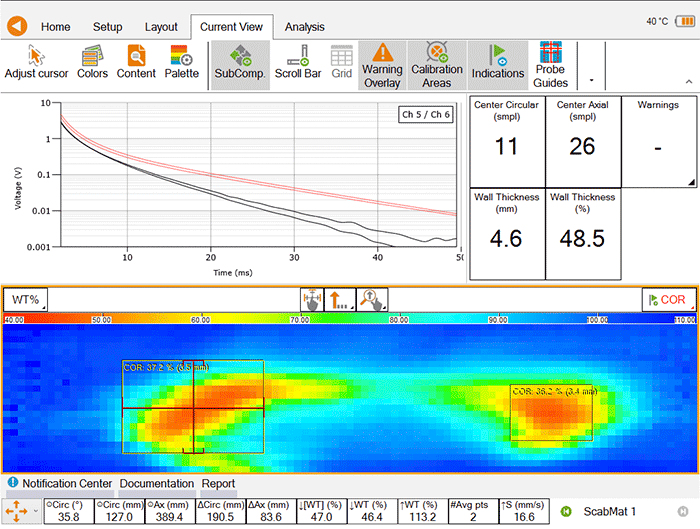
Lyft GO embedded software and Lyft PRO for laptop computers
The Lyft software ecosystem is in constant evolution. Lyft GO is the dependable and intuitive data acquisition software on the Lyft unit. Lyft PRO uses the same user interface as Lyft GO with added features for analysis and is the prime tool for advanced data analysis. Now with the new PermTool™ and Tau-scan™, Lyft PRO is the first software of the industry to offer advanced analysis curves dedicated to deepen comprehension of the PEC signal and increase confidence in inspection results. Download Lyft PRO here.
Desktop Analysis Software
SurfacePro 3D is the visualization and reporting software compatible with Lyft. It is designed to automatically create components and overlay stitched C-scan data. Import Lyft reports, create 3D components, and stitch color maps automatically. Easily import, export, create, and edit report templates. Compile and merge inspection data with associated images, inspection parameters, and defect tables for fast and compelling reporting. Download SurfacePro3D here.
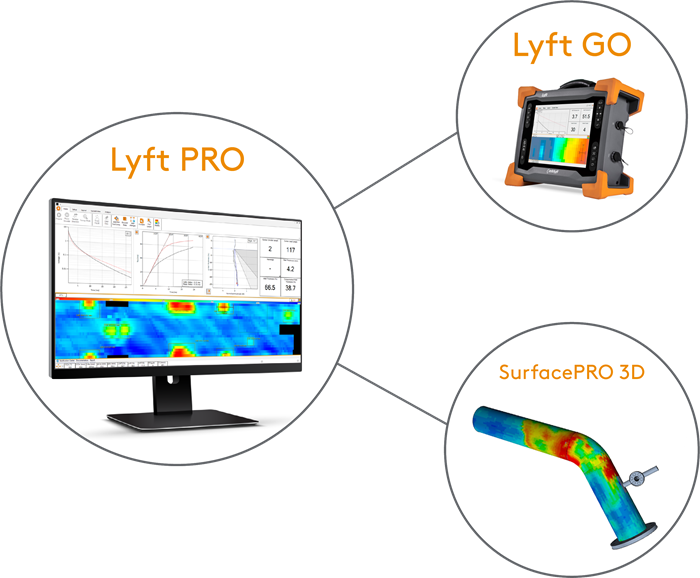
Optimized Performance for Wall Thickness and Liftoff
The Lyft solution includes several sizes of plug-and-play probes for the right balance between wall thickness and liftoff.
The PECA high-productivity probe is capable of a single-pass coverage of 457 mm (18 in) in grid or high-resolution encoded dynamic mode. It supports metal thickness 6–25 mm (0.25–1.0 in), insulation 0–102 mm (0–4 in), and stainless steel and aluminum weather jackets. CUI assessment has never been this fast, improving overall inspection productivity as much as 10 times.
The single-element PEC probe family supports metal thicknesses up to 100 mm (4 in), insulation as thick as 300 mm (12 in), and stainless steel/aluminium/galvanized steel weather jackets. They complement the array probes in limited-access, small-pipe, and thick-component inspections.
See pricing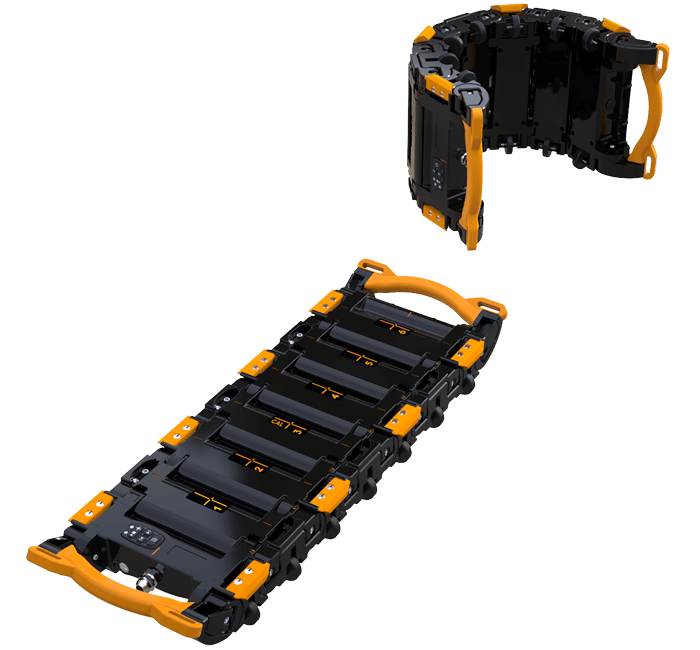
Application-Specific Probes
The patent-pending high-resolution PECA probe is designed specifically for the inspection of scabs and corrosion blisters. Using an array of dual sensors capable of spatial triangulation, the probe enables the detection of the smallest possible defects with PEC technology. It supports metal thickness 3–19 mm (0.12–0.75 in), insulation 0–50 mm (0–2 in) and a single-pass coverage of 75 mm (3 in) in dynamic or grid mode.
The tank floor probe enables the in-service inspection of storage tank annular rings. With its 4.8 mm (0.2 in) thick, super-thin titanium blade, the probe can slide up to 400 mm (16 in) under tank floor edges, assessing the remaining wall thickness of this critical region exposed to corrosion. The embedded remote controls and status LEDs are also perfect for one-person operation.
The patent-pending galvanized steel cladding probe (PEC-GS) is specifically designed to improve detection capabilities and sizing accuracy by reducing the footprint dimensions to normal. The design neutralizes the interference from the jacket, improving signal penetration, and prevents vibration for an unsurpassed signal-to-noise ratio.
The marine ship deck inspection solution showcases a cutting-edge 7-channel probe (PECA-7CH-SM). Meticulously designed for the radiation-free and efficient assessment of corrosion in steel ship deck plates, this high-resolution solution ensures comprehensive coverage, offering a detailed map of inspected compartments. Notably, the PECA ship deck inspection solution facilitates inspections without disrupting vessel service, providing a powerful and non-intrusive approach to maintaining marine infrastructure integrity.
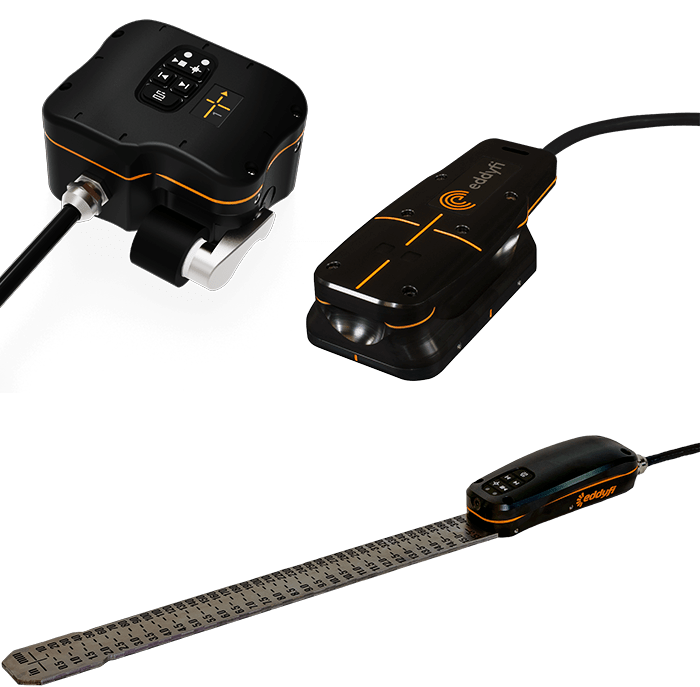
Splash Zone and Underwater probes
The splash zone probe can tackle offshore applications, thanks to its rugged design, water tightness to 15 m (49 ft) in grid mode, and 25 m (82 ft) cable. The splash zone probe is flexible enough to support metal up to 76 mm (3 in) thick and insulation or marine growth up to 203 mm (8 in) thick.
Underwater probes can tackle deeper offshore applications. They are watertight down to 100 m (330 ft) and, through the long extension cable, are used with Lyft in grid-mapping mode. The embedded status LEDs ensure better control and synchronization with the topside team. The probes can be used on metal as thick as 100 mm (4 in), as well as insulation and marine growth as thick as 300 mm (12 in).

The Best of PEC in a Portable Instrument
The Lyft instrument is sealed and designed for IP65. Its magnesium alloy casing is tough, water and dust resistant, and cools without any external air exchange. The adjustable stand, the top handle, and four corner anchor points make it practical for on-site inspections. The embedded and portable Windows® PC offers standard connect-anywhere capabilities and advanced productivity tools that optimize field testing. The premium-quality 26.4 cm (10.4 in) LED display is optically bonded, non-reflective, comes with 3 mm (0.12 in) strengthened glass, and is designed for gloved hands, under any lighting conditions. The system also comes with two, hot-swappable batteries for extended battery operation.
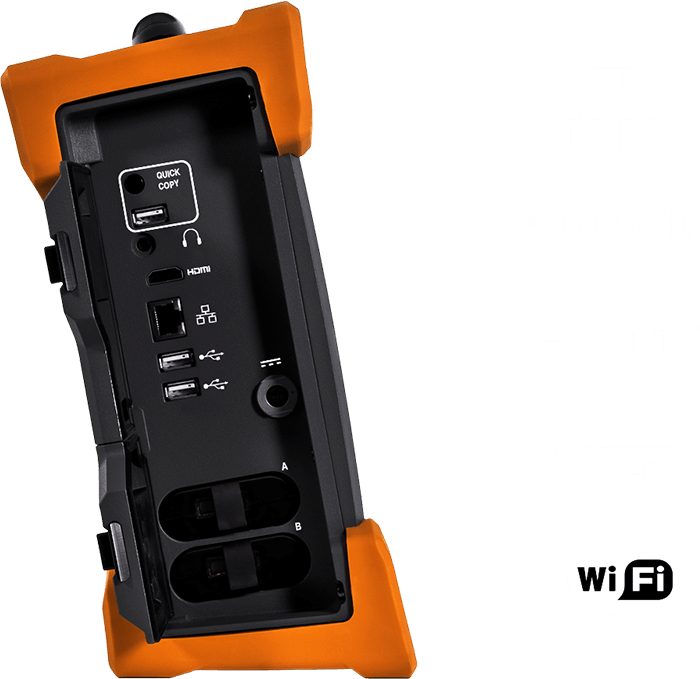
Global NDT Equipment New Product Innovation Award Recipient
For its dedication to creating a power-packed product that solves one of the major challenges across industries, testing for corrosion under insulation, Frost & Sullivan presented Eddyfi with the 2016 Global Nondestructive Testing Equipment New Product Innovation Award, read more.
"Eddyfi has further done away with the dependence on operators by packing Lyft with its SmartPULSE technology, wherein the system automatically iterates to find the best parameters for the inspection configuration.”
“Using an autoset feature, the probe can find the optimal configuration for measurements and repeatability, adjusting the pulse frequency, gains, and other parameters.”
Frost & Sullivan Principal Lead, Nikhil Jain

Get Eddyfi Certified Anywhere
We are geared to offer blended training: a combination of e-learning and hands-on training at our offices, yours or remotely that will give you the necessary knowledge and skills to efficiently use PEC when inspecting assets. Visit the Eddyfi Academy to enroll for a PEC training course or Contact us for details or to book a training session.
It is also possible to enroll in the free introduction to PEC course to learn more about the PEC technology.

Exclusive Content
Complete scab corrosion webinar
Check out our webinar dedicated to the complete scab corrosion solution. It is also the perfect occasion to learn more about the latest Lyft 2.2 software version.
The webinar covers:
- Basics of Pulsed Eddy Current (PEC) technology
- The new patent-pending PECA™ high-resolution probe
- The new high-performance solution for scab assessment
- Demonstration of an acquisition over scab corrosion
- New warning overlay overview
- Sizing and data analysis
Breakthrough in Pulsed Eddy Current Detection Sizing
Our team presented this paper at Corcon 2019 and was awarded "Best Paper in the Symposium - Marine Corrosion and Offshore".
Specifications
INSTRUMENTS
- 355 × 288 × 127 mm (14.0 × 11.3 × 5.0 in)
- 6.6 kg (14.5 lb)
- 7 (GDA)
- 26.4 cm (10.4 in)
- Multi-touch
- Non-reflective (AR coating)
- Anti-fingerprint (oleophobic coating)
- 3 mm (1/8 in), chemically strengthened glass cover
- Optically bonded LCD and touchscreen
- Passive blacklight enhancement
- Gigabit Ethernet, Wi-Fi™, Bluetooth®, 3 × USB 2.0
PERFORMANCE
- Up to 15 points/s
- Up to 75 mm/s (3 in/s)
- Instant, less than 1 second (typical)
- Automatic configuration of PEC pulser-receiver parameters
- Full thickness sensitivity (OD and ID flaw detection)
- Reliable measurements even with liftoff variations, weather jackets overlaps, straps, and corrosion scabs
- Repeatability optimization
- One-point calibration (on nominal wall or known thickness value) and auto-normalization
PROBES
- Remote control keypad
- Lyft 27-pin Fischer connector
- Heavy-duty 5 m (16.4 ft) cable
- Support for universal clip-on encoder
- Up to 102 mm (4 in)
- PECA-6CH-MED: 0–102 mm (0.4 in)
- PEC-152G2: 0–305 mm (0–12 in)
- PEC-089-G2: 0–203 mm (0–8 in)
- PEC-025-G2: 0–76 mm (0–3 in)
- 15% of footprint volume (footprint × wall thickness)
- 15% from nominal
- Stainless steel up to 1.5 mm (0.06 in)
- Aluminium up to 1 mm (0.04 in)
- Galvanized steel up to 1 mm (0.04 in)
- Down to 25 mm (1 in)
- Carbon steel structure temperature range: -150–500°C (-238–932°F)
- Maximum weather jacket temperature for direct contact operation: 70°C (158°F)
- Maximum weather jacket temperature with probe shoe: 120°C (248°F)